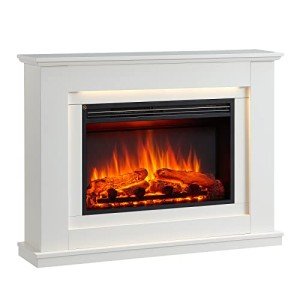The Fireplace: A Warm Embrace of Tradition and Comfort
Fireplaces have actually been an essential part of human habitation for centuries, serving as a source of heat, an event place, and a symbol of convenience. While the modern variations might vary extremely from their ancient forefathers, the attraction of a fireplace endures. This post checks out the different elements of fireplaces, including their history, function, types, and maintenance, while also resolving frequently asked concerns.
The Evolution of Fireplaces
Fireplaces date back to prehistoric times when open flames were used for cooking, heating, and security from wildlife. Over the centuries, fireplaces progressed from basic fire pits to the advanced performances we see today. Here is a quick timeline of their evolution:
- Prehistoric Era: Cavemen used open flames for heat and cooking. Wind and smoke often blew into residences.
- Middle Ages: Stone and brick fireplaces became common in homes and castles, integrating chimneys to bring smoke outside.
- Renaissance: Elaborately developed mantels emerged, and fireplaces became centers of social interaction.
- Industrial Revolution: Innovations in heating products led to a variety of designs and performances.
- Modern Era: The advent of gas, electric, and bioethanol fireplaces provided cleaner alternatives to traditional wood-burning systems.
Table 1: The Evolution of Fireplaces
| Period | Characteristics |
|---|---|
| Ancient Era | Open flames for warmth and cooking |
| Middle Ages | Stone and brick structures with early chimneys |
| Renaissance | Elaborate mantels, social centers |
| Industrial Revolution | Diverse designs, development of brand-new materials |
| Modern Era | Gas, electric, and bioethanol alternatives |
The Purpose of a Fireplace
Fireplaces serve dual purposes: they offer physical warmth and produce a psychological environment. Homeowners often gather around the fireplace to bond, share stories, and take pleasure in a cozy setting. The radiance of a fire can be calming, adding to a sense of relaxation and intimacy. Beyond individual satisfaction, fireplaces also offer functional advantages, including:
- Home Heating: Effective heat source, especially in colder environments.
- Increased Home Value: A properly designed fireplace can enhance the visual worth of a home.
- Emergency situation Heating: In case of power failures, wood-burning fireplaces can function as an important heat source.
- Aesthetic Appeal: A focal point that contributes to interior decor.
Types of Fireplaces
Today, fireplaces can be found in various styles and fuel types, accommodating a diverse variety of choices and settings. Here are some typical types:
Wood-Burning Fireplaces:
- Traditional fire pits
- Traditional masonry fireplaces
- Need significant upkeep and chimney maintenance
Gas Fireplaces:
- Available in both direct vent and ventless varieties
- Much easier to use and maintain than wood-burning fireplaces
- Provide instantaneous heat with a flick of a switch
Electric Fireplaces:
- Offer associated heat sources without real flames
- Often designed to mimic traditional fireplaces
- Ideal for smaller sized spaces and homes without a chimney
Bioethanol Fireplaces:
- Use bioethanol fuel, providing a sustainable option
- Need no ventilation and can be put anywhere
- Safe and easy to preserve
Table 2: Types of Fireplaces
| Type | Fuel Source | Features | Upkeep Requirements |
|---|---|---|---|
| Wood-Burning | Wood | High ambiance, heat source | Routine chimney cleaning |
| Gas | Natural gas or gas | Immediate heat | Minimal, occasional maintenance |
| Electric | Electricity | Easy setup | Very low maintenance |
| Bioethanol | Bioethanol fuel | Ventless, portable | Low, mainly cleaning up |
Maintenance and Safety Considerations
Owning a fireplace includes specific duties, especially regarding its safe operation and long-lasting maintenance. Here are important upkeep suggestions and safety standards:
Maintenance Tips:
- Annual Inspection: Always have your chimney and fireplace inspected at least once a year by a certified specialist.
- Regular Cleaning: Clean out ashes and particles after each use, and make sure the flue is open before starting a fire.
- Inspect for Cracks: Inspect masonry for fractures or damage to prevent structural concerns.
- Use Proper Fuel: Only usage dry, skilled wood for wood-burning fireplaces; do not burn cured wood.
Security Guidelines:
- Install Smoke Detectors: Ensure smoke alarm are practical, testing them monthly and replacing batteries as needed.
- Keep a Fire Extinguisher: Have one neighboring, even if a fireplace is utilized infrequently.
- Monitor Flames: Never leave a fire ignored, and guarantee children and animals are kept track of around the fireplace.
Often Asked Questions (FAQs)
1. How can I lower smoke from a wood-burning fireplace?
To lessen smoke, use dry, experienced wood, and make sure that your chimney is clean and unblocked.
2. Is view to utilize gas fireplaces during a gas leak?
Never ever use a gas fireplace throughout a gas leak. Immediately evacuate the location and contact gas services for assistance.
3. Can I set up an electric fireplace myself?
Electric fireplaces are usually easy to install, but it is recommended to speak with experts to make sure security and compliance with regional structure codes.
4. What is the best kind of fireplace for small spaces?
Electric fireplaces or bioethanol designs are typically best for small areas, as they do not require comprehensive ventilation or structural adjustments.
Fireplaces have transcended their original purpose of offering heat to end up being cherished aspects of home style and domesticity. They evoke memories of heat, celebrations, and togetherness while offering functional advantages that boost modern living. By understanding the different kinds of fireplaces, their upkeep, and safety practices, house owners can take pleasure in the ageless appeal of this precious function for generations to come.

